Apple had an event yesterday to launch a new M4 chip, a thinner and improved iPad Pro, an updated iPad Air range, an improved Pencil Pro, plus major updates on the Pro Apps side for Final Cut Pro and Logic Pro. Here’s everything in one place.
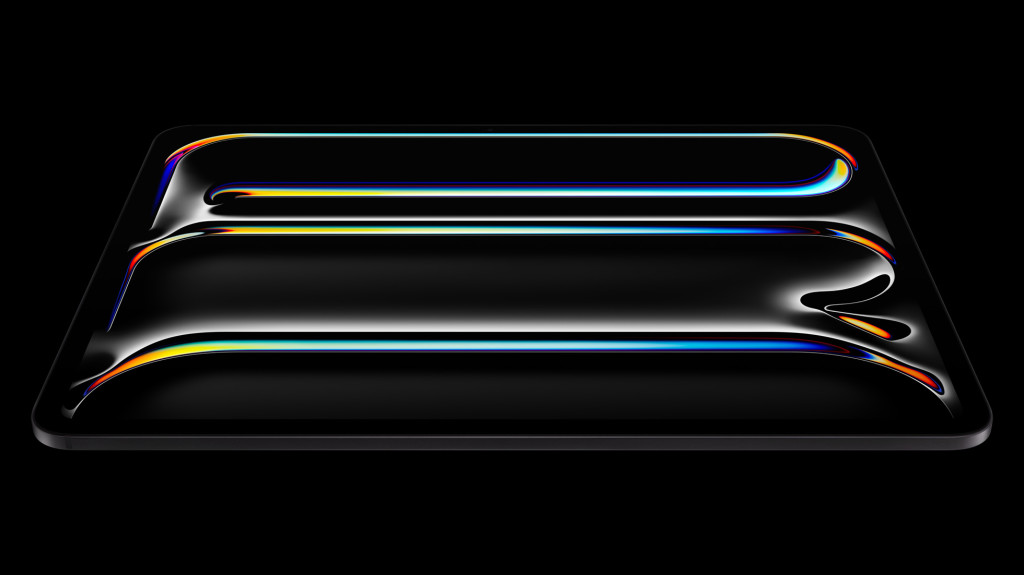
What’s new with iPad Pro
I really like that the iPad hype has faded in some ways, because now the device is at a mature stage where it almost disappears – and we focus on what we can do with it. (It’s also worth taking a look at iPadOS 17.)
Disappearing is maybe the most relevant term. The most recent generation iPad Pro was incredible, but was also pretty hefty, especially once you added a case/keyboard like the Magic Keyboard. Apple has managed to use its manufacturing prowess here to make something with both more advanced Apple Silicon inside and what they say is the company’s “thinnest product ever.”*
Of course, I should add – the usual applies. New Apple hardware? Check pricing on the previous generation – and that holds here as always!

Ultra-thin: 5.3mm on the 11″, 5.1mm on the 13″ – proportionally, this feels thin like a phone, but in the footprint of an iPad.
Lighter: less than 1 lb (half a kg) for the 11″, shedding a quarter pound on the 13″
New Ultra Retina XDR display, plus nano-texture glass option on iPad Pro for working in tough light conditions or color-managed workflows. That’s paired with new iPadOS features for color matching and whatnot.
M4 architecture debuts, which brings roughly 1.5x-fold CPU gains and the first time ray tracing and mesh shading hardware acceleration come to the iPad, plus more advanced onboard machine learning capabilities
Here’s the big one – the performance per watt improvements means they give you the same performance in half the power
Media Engine improvements with AV1 decoding
Pro Cameras – now with the True Tone flash you know from the iPad and other quality improvements. They also tout some new AI-assisted document capture capabilities, which is probably where the iPad camera sees the most use for some of us. But yeah, the camera stuff matters in part because it means that those of us collecting Apple gizmos now can get away with fairly half-decent multi-cam setups for video just using these and not bringing anything else. It’s also now in Landscape Orientation which makes way, way more sense.
USB-C with Thunderbolt 3 and USB 4 support, which is kind of ridiculous.
There’s also an “all-new” Magic Keyboard and Smart Folio. I’m curious about these, as this was sort of the weak spot of the previous generation. “Thinner and lighter” is the main lead, but notably, the Smart Folio has a detachable keyboard and supports multiple viewing angles. You can read Verge lamenting the loss of the old Smart Folio, but for musicians the detachable keyboard is about perfect – since you don’t want the keyboard when you play. The new Pro version has the “floating” angle of the previous generation but is a more robust, MacBook-like keyboard. That, for me, is a big boost from the previous generation’s Magic Keyboard, which was in a weird spot between the two – too much like a mobile keyboard for typing, but kind of useless when you weren’t typing or needed different viewing angles.
The machine learning stuff is interesting, as Apple says this allows the M4 to perform tasks like Final Cut’s Scene Removal Mask more efficiently. So when they talk about an “outrageously powerful device for AI,” maybe the best thing to watch is for mobile workflows – where that AI assist could be really important.
It could be the sleeper hit here: imagine a creative device that performs some fast video edits while you’re on the go, or assists you in 3D capture and modeling. I already use my mobile Apple gadgets that way. It’s something people could easily miss about “AI” as that’s such a broad category: for creative use, this may be more about reducing some workflow obstacles and working in mobile situations, rather than the “type in text to make music and art” angle the VCs seem to love so much.
*You know I’m enough of an Apple history nerd to want to prove them wrong on the “thinnest product” claim. The company did make official mousepads back to the Macintosh (Apple Garamond) era, if we want to be ridiculously pedantic – maybe someone else can remember something.
Newsroom article: Apple unveils stunning new iPad Pro with the world’s most advanced display, M4 chip, and Apple Pencil Pro

iPad Air
The iPad Air will be the sweet spot for many people – it’s mid-range on price but packs enough processing power for all the apps and works with the new keyboards and Pencil Pro (plus the older USB-C Pencil). So while consumption-focused customers will be happy with a basic iPad for games and movies, the Air gives you essentially the advantages of the Pro without the price. It’s $599 for the 11″ model, with a new roomier 13″ model at $799. (As a one-off purchase, that’s not insignificant, but it’s worth noting that these devices are often purchased with finance plans or on phone contracts.)
New here:
- Two sizes, including 13″: That 13″ model finally gives the Air line a roomier option, which really comes in handy for some music and visual apps.
- Landscape Front-Facing Camera. Yeah, kind of the only way this makes sense – and now with Machine Learning for centering the camera image, this is also a no-brainer for an extra camera without needing a person to operate it.
- M2 performance. Affinity Designer, Logic Pro and Final Cut Pro, DaVinci Resolve, extra machine learning and whatnot, all that stuff now runs on the Air in case you can’t budget for a Pro.
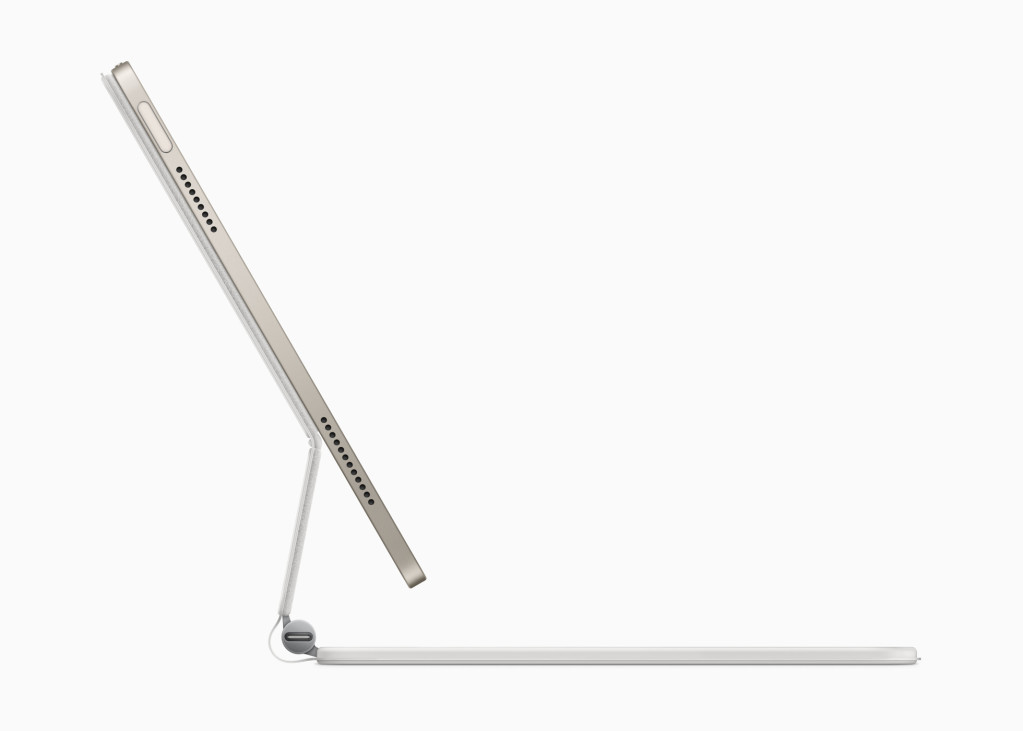
There’s more to say, but this also makes a great device for 3D capture and whatnot. Apple’s biggest competition is itself, of course – if you just need an iPad to run some music apps, almost any model, including a lot of relatively old devices, works really well. But this is a strong entry-point to more powerful apps and compatibility with Pencil, including the redesigned Magic Keyboard (above) and the new Pencil Pro.
Oh yeah…
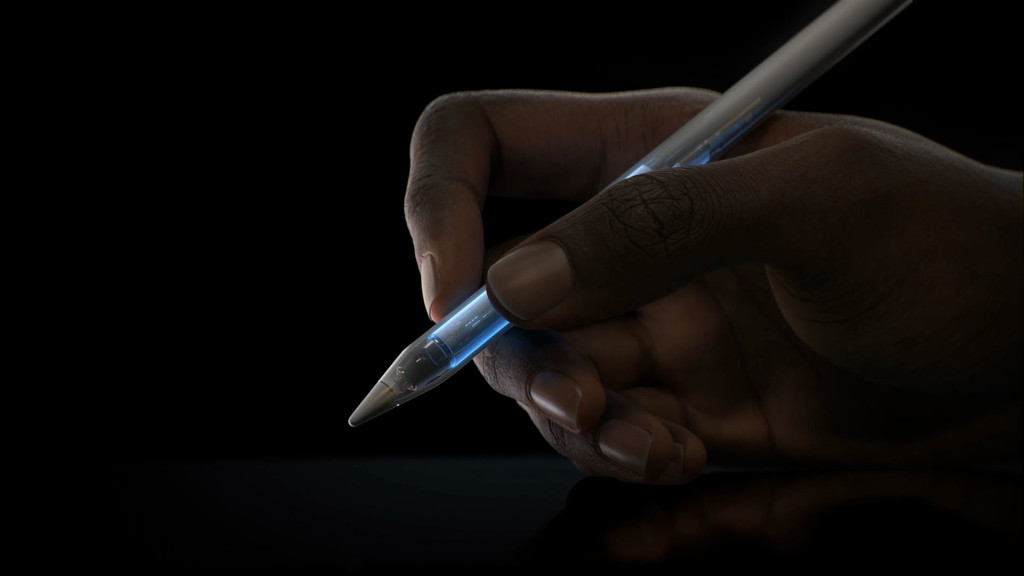
Apple Pencil Pro
The new iPads work with the Apple Pencil if you have one, but if you don’t, you can look at the new Pencil Pro for some additional functionality:
- Squeeze sensor (for quickly swapping tools, etc.)
- Custom haptic engine for feedback from squeeze, double-tap, Smart Shape snapping
- Gyroscope
- Barrel rotate for orientation changes, just as with real pen and paper
- Hover
Gosh, remember when we used Wacom tablets?
What’s new in Final Cut Pro
It’s Live Multicam! You could just about skip this whole article if you’re pressed for time and hear this – Live Multicam in Final Cut Pro across iPad and iPhone. Done.
But there’s more. I’m particularly excited to dig into Final Cut Pro for iPad 2, as the first version promised a lot that we didn’t really get to see fully come to fruition. I love the idea of a mobile app that lets you use Motion templates and whatnot in that on-the-move workflow.
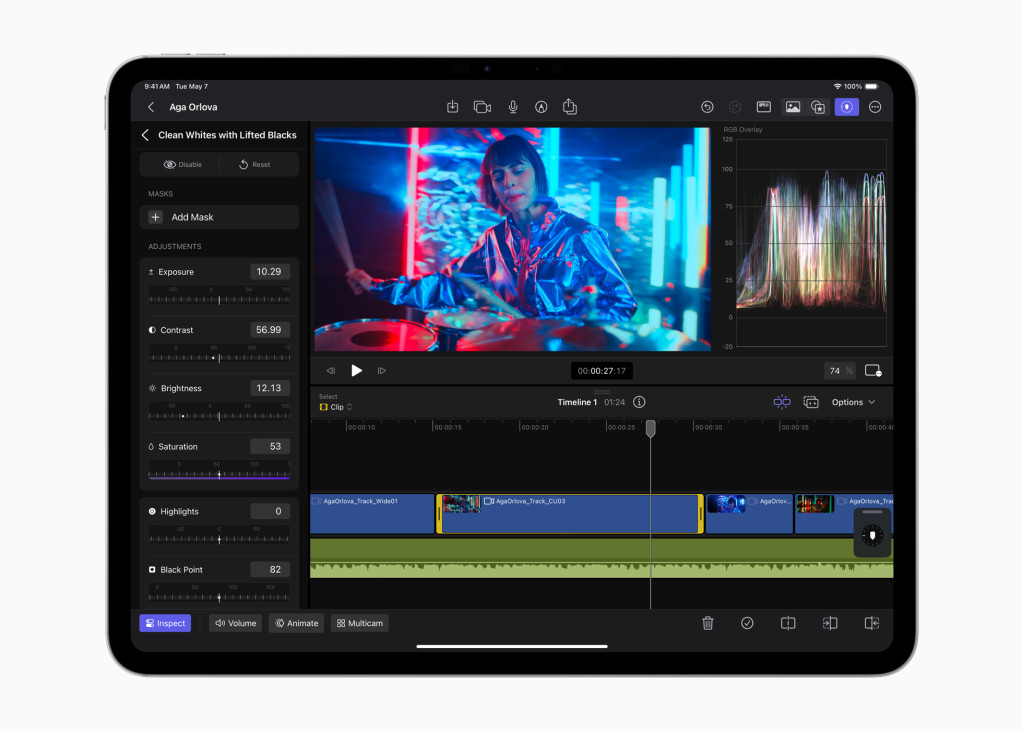
On iPadOS:
- Live Multicam allows up to four angles – I think not limited to Apple device inputs (I’ll check), but supporting the new Final Cut Camera app so you can use any mix of up to four iPads and iPhones.
- Final Cut Camera for both live monitoring and individual control across apps of each camera – including ISO and shutter speed, focus peaking, etc. And it’s free.
- External Project support (finally)! Create or open projects on external drives, and hand off between users or over to Final Cut Pro for Mac.
- ProRes and Log support.
- Customization. 12 new color grading presets (not sure if you can import looks – please!), eight text titles (same, wondering if there’s import), and dynamic backgrounds (yeah, looking for Motion templates).
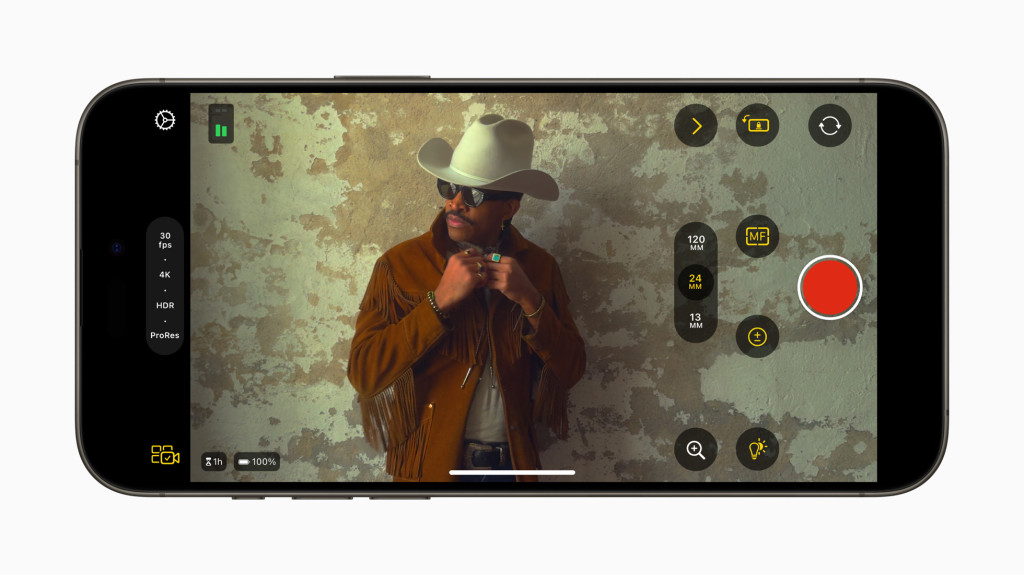
You could just about skip this whole article if you’re pressed for time and hear this – Live Multicam in Final Cut Pro across iPad and iPhone. Done.
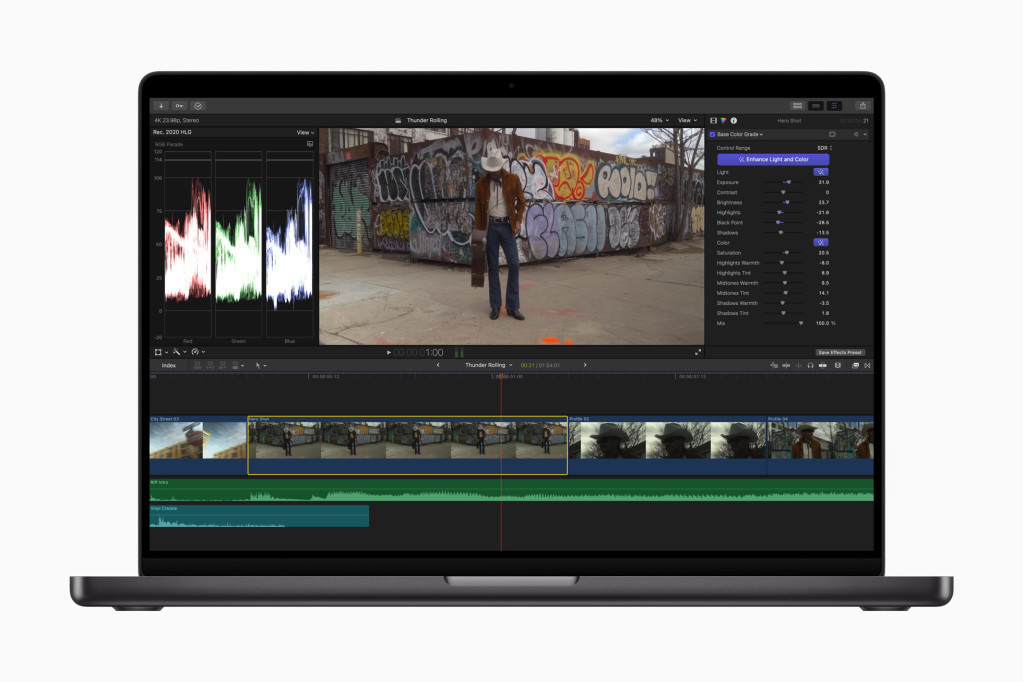
On the Mac, as with Logic – more Neural Engine features, among others:
- One-step Enhance Light and Color options, AI-powered.
- Smooth Slo-Mo, also based on ML.
- Custom names for Color Corrections, Video Effects.
- Search for/navigate to clips with missing media or effects to replace them quickly.
- Text-based timeline search (including reel, scene, camera angle, etc. – plus presumably text titles and whatnot).
I’m actually unclear on whether there’s Final Cut Camera support on the Mac, too – that seems like it’d be a great workflow. But in general, while I know Final Cut has its detractors, wow, Apple’s software can be fast to work with. I was talking about mobile workflows, but honestly that can include a Mac as much as an iPad.
I expect we’ll go over this in more detail as it arrives next week.
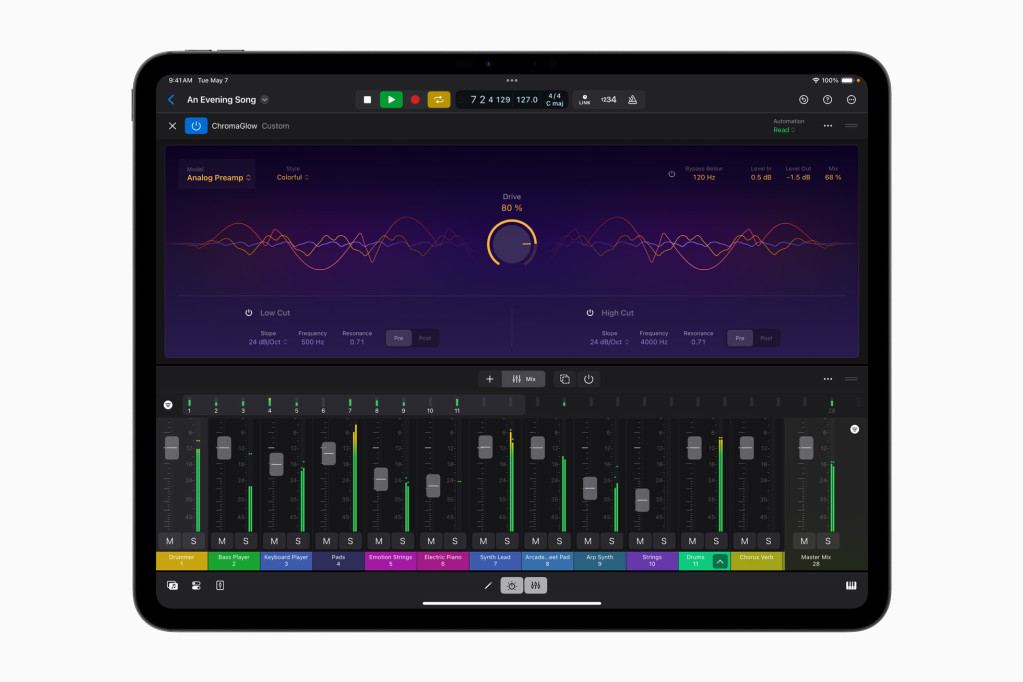
What’s new in Logic Pro
I’m going to be quick here as I’ll review both the new Pro Apps and their iPadOS counterparts. But here’s a quick look at features – and Apple is now introducing both its desktop and mobile apps simultaneously for Logic and Final Cut.
Coming next week at launch:
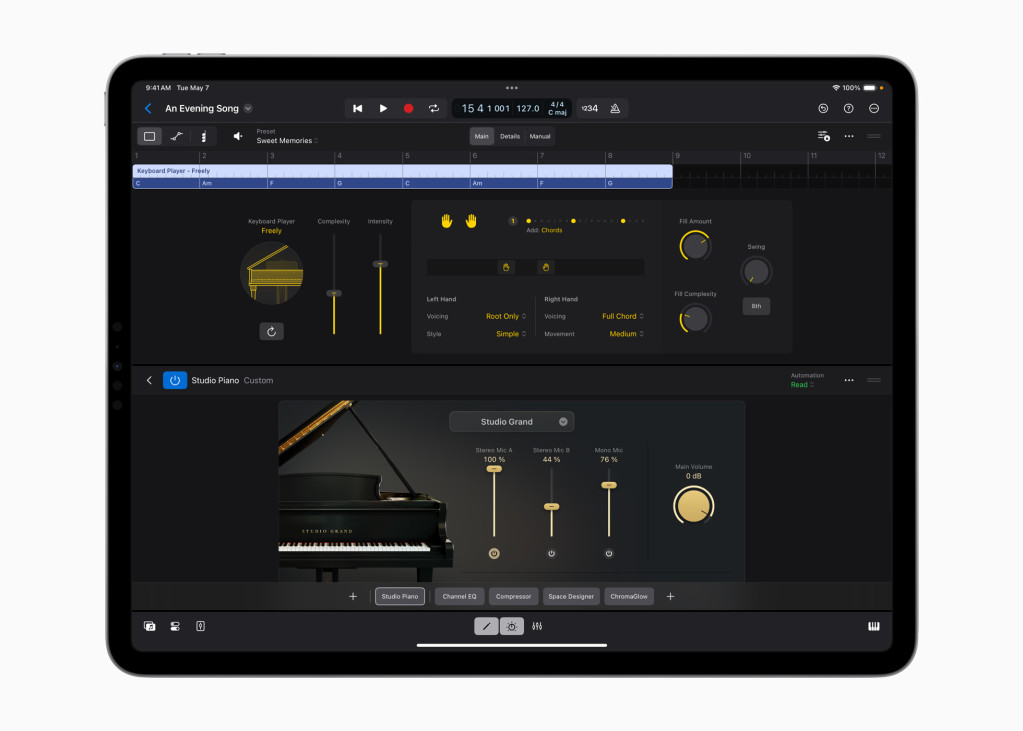
- Session Players (Drummer, plus now Bass Player and Keyboard Player) are machine-learning driven and respond go feedback. That looks great as a practice tool, especially in the iPadOS versions. This is impressive speaking as someone who suffered through my high school band teacher making us play with Band-in-a-Box in the 90s.
- ChromaGlow is a new saturation tool also based on AI, Apple says. (Now, whether that’s actually helpful or not, we’ll have to test.)
- Stem Splitter is yet another machine learning-driven tool, this one for stem separation.
That is a short, short, short feature list for a Pro App release, so stay tuned for the full news when it’s available.
iPad impressions
I have really rediscovered the iPad over the past year, both with some incredible work from music and visual developers and the latest hardware. The iPad Pro as a second display is invaluable. That includes working with the desktop version of software like Final Cut Pro with the iPad as a second display, especially on the go. It’s also terrific as a sketchpad with Pencil Pro, which again works well with a MacBook Pro. And the iPad is a lifesaver when you can’t haul a bunch of gear. I’m on the road for a month and traveling with just carry-on luggage, so the iPad solved that. (Those luggage fees add up fast.) Plus, I wanted to spontaneously play with my colleague at MUTEK festival – solved. I was able to hand off my iPad to her with a pair of headphones to let her practice outside the venue, then drop the thing onstage.
Or another example: last night, a friend who’s sharing a residency I’m in here in the West Bank pulled out his iPad Pro and finished off some product design with the Pencil while we sat with friends outside drinking beers. He said this drops some product design tasks from 8+ hours to two.
I say this just because these use cases tend to evolve over time. They’re not about the brand-new product but the ways we use them in the long run when the product itself disappears. And it’s great that the iPads are such indestructible rather than disposable devices.
Now, I think add Live Multicam to this stuff, and you can wrangle some Apple gadgets for some serious quick-and-dirty low-cost production. Sounds great to me.
More soon.
Oh… the ad
Addendum: Oh, I had not seen the ad. Eesh, even the thumbnail was a terrible choice.
The only slightly good news here is, this is better than what I’d argue was the worst Apple ad of all time, “Lemmings.” Then again, that ad ultimately led to Chiat/Day being fired as Apple’s ad firm, not to mention being part of a sequence of events that led to Steve Jobs being fired. Oh, and because of issues with the file server and other missteps, Macintosh Office never shipped. Maybe this is not a good thing to remind Apple of.
Look, let’s just cheer up and watch the classic Ellen Feiss ad.